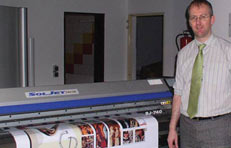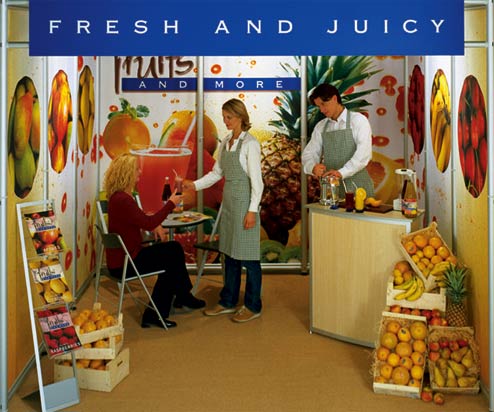Zeppelinring, Germany
Proprietary brand makers and market leaders can only present products successfully with high-quality visuals. And new ECO-SOL MAX ink are designed expressly for this.
From the beginning we have been printing at the highest quality levels. In a production chain, all activities have to be geared optimally to work with one another. The printer, medium and color together determine the print result. Another factor is the light durability. Our clients require photo-realistic reproductions of digital data, and then display these reproductions for extended periods of time on mobile display systems, even in harsh sunlit environments.
For us, Roland piezo technology was a decisive breakthrough. For years we have been testing printing products, and we have seen that Roland printers boast outstanding results when it comes to reproducibility, uniformity and productivity.

When the second generation of Roland’s eco-solvent ink became available, we equipped a Roland SOLJET SJ-740 printer with it. We were interested in the high light durability of the ink for the panels of our mobile display systems. The outside use of these prints was secondary. With select coated materials for eco-solvent inks, good photo-realistic picture reproductions were generated. However, there was room for improvement. These inks were not as scratch-resistant as the inks we have today and they did not dry as quickly.
New Eco-Sol Max Ink - No Compromises
When new ECO-SOL MAX ink became available, we immediately converted our two SJ-740 printers to MAX. The color lays down optimally, without anycolor loss. MAX’s drying time isadequate as well. After the inks have dried, the scratchresistance is really good. All together, ECO-SOL MAX ink are a clear improvement.
|
|
 |
Even after the long holiday “recess,” MAX's inks did not dry underneath the print heads. Additionally, Roland supports MAX ink with an adjusted and optimized firmware. All printer parts are well geared to perform with the inks. Even at higher print speeds, there are no color stripes or banding lines. MAX inks also enable printing on properly coated textile materials. Excellent results are achieved when using coated photo papers as well. And we get acceptable print quality with non-coated materials. With new ECO-SOL MAX inks and the right materials, one can achieve a print quality which is virtually indistinguishable from high-quality pigment ink prints. Due to MAX’s high light durability, these graphics last a long time indoors and out. For more information visit our website at: www.universal-decor.de

|
|
In Comparison with Pure Solvent Ink
A client who ordered a few thousand square meters of panels for display systems asked us for a very intense red reproduction, a color that is possible to achieve with pure solvent inks.
Instead of using Roland eco-solvent inks, we equipped two Roland SJ-740s with a new sort of ink, one in which the solvent substance lies somewhere between a solvent and an eco-solvent. This new ink achieved the required red color indeed, dried faster, and was scratch-resistant as well. Yet it had serious disadvantages, particularly with respect to the print production process. The fast-drying solvent caused the ink to dry underneath the print heads, a problem that resulted in continuous clogging of the nozzles. The viscosity of the ink did not allow a high productivity level, and banding lines appeared quickly.
After a few weeks these more aggressive solvents had destroyed parts of the printer, causing print head failures. Furthermore, the ink hardened in the wires. All this led to continuous interruptions of the print production cycle and demanded timeconsuming and costly repairs.
|
